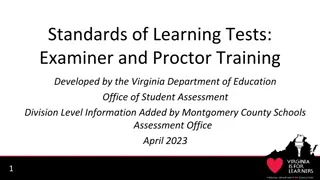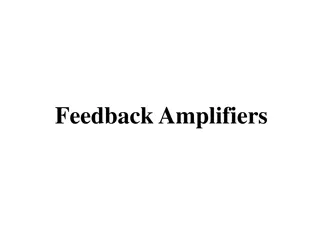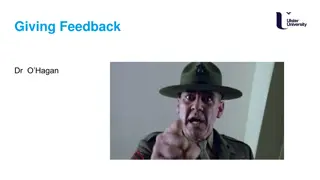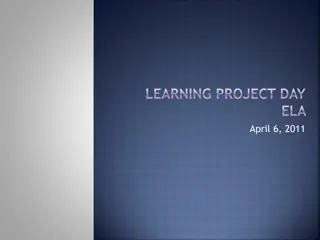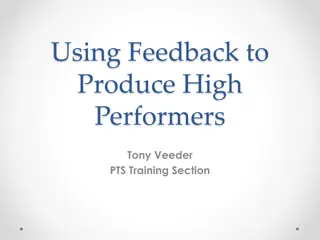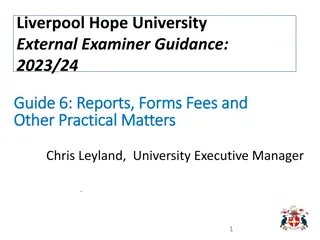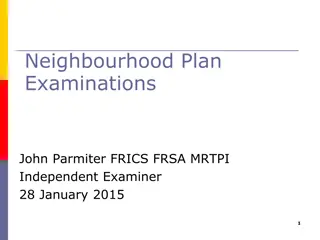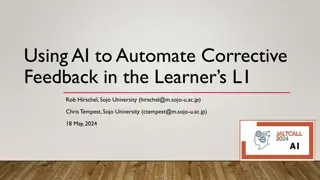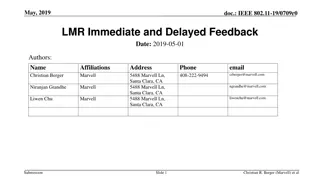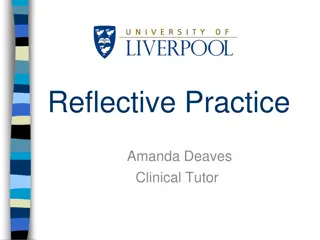Paper 1 Examiner Feedback - Areas for Reflection
This feedback highlights strengths and weaknesses of the working memory model, practical issues, generic responses, and challenges in achieving high levels on extended response questions. It also addresses the importance of applying knowledge in stimulus contexts to earn marks.
Download Presentation

Please find below an Image/Link to download the presentation.
The content on the website is provided AS IS for your information and personal use only. It may not be sold, licensed, or shared on other websites without obtaining consent from the author.If you encounter any issues during the download, it is possible that the publisher has removed the file from their server.
You are allowed to download the files provided on this website for personal or commercial use, subject to the condition that they are used lawfully. All files are the property of their respective owners.
The content on the website is provided AS IS for your information and personal use only. It may not be sold, licensed, or shared on other websites without obtaining consent from the author.
E N D
Presentation Transcript
Introduction 30 Minute Webinar 2 Papers (Select questions) 2016 First cohort of new AS Level specification AS Level Paper 1 Social and Cognitive AS Level Paper 2 Biological and Learning Topics (Social, Cognitive, Biological & Learning) covered + Issues and Debates = Paper 1 A Level Teething problems Incorrect guidance during training courses New examination terminology No longer two command words etc Content change
Paper 1 Examiner Feedback - Positives What did the examiners say? Many candidates demonstrated good psychological knowledge and understanding Centres have clearly covered the required content in sufficient depth Very few unanswered questions Strengths were seen in the understanding of obedience and Milgram, along with the procedure of contemporary studies
Paper 1 Examiner Feedback - Areas for Reflection Content Strengths and weaknesses of the working memory model Social Practical Generic and limited responses to improvements, not clarifying how or why this would improve their own practical, Incorrect practical Methods Writing a hypothesis Extended Response Questions Structure Struggle to achieve high levels on all the extended open response questions of 8 marks and above Generic points were given when evaluating studies Taxonomy of questions 'Evaluate' and 'assess', for example, are different skills Application Questions Candidates are not applying their knowledge and understanding for AO2 marks when directed to explain a concept in a stimulus context
Paper 1 Examiner Feedback - Areas for Reflection Content Strengths and weaknesses of the working memory model Social Practical Generic and limited responses to improvements, not clarifying how or why this would improve their own practical Incorrect practical Methods Writing a hypothesis Extended Response Questions Structure Struggle to achieve high levels on all the extended open response questions of 8 marks and above Generic points were given when evaluating studies Taxonomy of questions 'Evaluate' and 'assess', for example, are different skills Application Questions Candidates are not applying their knowledge and understanding for AO2 marks when directed to explain a concept in a stimulus context
Paper 1 Social Practical Social Practical Question 4b Suggest one improvement you could make to the procedure of your practical investigation. (3) Mark scheme Up to two marks for explaining an appropriate improvement (AO2) One mark for how it would improve study (AO3)
Paper 1 Social Approach Social Practical Question 4b: Suggest one improvement you could make to the procedure of your practical investigation. (3) 1. My practical used 10 participants, so is not very generalizable. Next time we should use more participants. 2. My practical used 10 participants, so lacks population validity. Next time if we use more participants this would be improved as the sample would have greater variation. 3. My social practical was a questionnaire and used a sample of 10 participants, so therefore the sample may not have represented the wider population and lacks population validity. To improve our study we should increase our sample size, to ensure there is a greater representation of students views on the older generation and to make our results more generalizable. A group of 100 participants may be more appropriate.
Paper 1 Generic Evaluation Q3). Sherif et al. (1954/1961) conducted The Robbers Cave Experiment to investigate intergroup conflict and cooperation. Evaluate The Robbers Cave Experiment conducted by Sherif et al (1954/1961). (8) Q8c). Baddeley (1966b) conducted a laboratory experiment to investigate the influence of acoustic and semantic similarity of words on long-term memory. Evaluate Baddeley s (1966b) study. (8)
Paper 1 Generic Evaluation E.g. Sherif Embedding AO1 within AO3 skills 1. The study was a field experiment and therefore has strong ecological validity as it was conducted in a setting familiar to the participants. 2. The Robbers Cave study was a field experiment and therefore has strong ecological validity as it was conducted in a setting familiar to the boys. 3. The Robbers Cave study was a field experiment, which took place at an American summer camp. It therefore has strong ecological validity as it was conducted in a setting familiar to the 22 middle-class white boys who were the participants. It has high mundane realism due to the natural setting.
Paper 1 Application Questions Q9). Ed and Najeeb are researching the effects of individual tutorials on student wellbeing. Ed wants to carry out a laboratory experiment and collect quantitative data, whereas Najeeb feels they should use interviews to collect qualitative data. Evaluate the use of quantitative and qualitative data when conducting research into psychological issues. You must make reference to the context in your answer. (12)
Paper 1 Application Questions Quantitative data is numerical, so can use statistical test to analyse it. These produce results which can be tested for reliability and which are objective, unlike qualitative data. Ed s decision to use quantitative data will provide statistical evidence, which means he could use a statistical test (Wilcoxon) to analyse his data. This is a strength because statistical tests improve the objectivity and reliability of findings, particularly if test-retest or inter-rater reliability checks are used. The results of the test are also numerical which avoids the subjective interpretation which may occur with Najeeb s use of qualitative data obtained from interviews.
Paper 1 Overall Student Advice (Examiner s Report) Where an extended open response question (8 marks or more) is used, candidates should focus their response purely on the taxonomy used, rather than give additional descriptions. Candidates should give balanced responses with informed conclusions or judgements (where appropriate to the taxonomy used) in their extended open responses. Candidates should apply their understanding to the behaviour or context in a given scenario, not just give a name. Evaluation points, strengths and weaknesses should be specific not generic (particularly in evaluations of studies). Explanations should be exemplified, not just described. Use of supporting evidence for evaluations, strengths and weaknesses would aid candidates in exemplifying their points. It should be made clear in responses about candidate practicals exactly what the practical was that they completed. The IV in a hypothesis requires both conditions, and the IV and DV should always be fully operationalised.
Paper 2 Biological and Learning Overall similar issues to Paper 1, but more SAQs and Data Response Questions
Paper 2 Examiner Feedback - Positives What did the examiners say? Candidates attempted most elements of this paper Responses were generally good and consistent throughout the paper demonstrating some knowledge and understanding across both biological and learning psychology Most candidates to apply their answers to the contextual questions
Paper 2 Examiner Feedback - Areas for Reflection Content Different strengths and weaknesses of scanning techniques Punishment vs Negative Reinforcement Methods Writing hypotheses fully operationalised Some centres had not delivered the skills necessary for completion of inferential statistics Evaluation of correlational designs Extended Response Questions Evaluation of theories would benefit from an improved focus on research studies and evidence to provide support for their answers Candidates struggled to complete the A03 development needed Application Questions Some candidates did provide generic answers Question Taxonomy Assess
Paper 2 Examiner Feedback - Areas for Reflection Content Different strengths and weaknesses of scanning techniques Punishment vs Negative Reinforcement Methods Writing hypotheses fully operationalised Some centres had not delivered the skills necessary for completion of inferential statistics (See Tutor2u video guides!) Evaluation of correlational designs Extended Response Questions Evaluation of theories would benefit from an improved focus on research studies and evidence to provide support for their answers Candidates struggled to complete the A03 development needed Application Questions Some candidates did provide generic answers Question Taxonomy Assess
Paper 2 Question Taxonomy Q3). Assess how far evolution and natural selection can be used to explain aggression. (8) What did the exam board state? Balance is key Description and Evaluation Each paragraph should embed both skills Key terms very important Comparisons with other explanations as evaluation THEORY Some candidates tried to evaluate using GRAVES - SAMS or SCOUT more appropriate SAMS (Studies, Application, Methods, Specific Criticisms) SCOUT (Supporting evidence, Contradicting evidence, Other theories, Usefulness, Testability)
Paper 2 Question Taxonomy (Mark scheme) Description Evaluation Supporting research for genetic link to aggression Chester et al. (2015): Low functioning MAOA genotype ( warrior gene ) was linked to greater aggression Mertins et al. (2011): High functioning MAOA genotype was associated with greater prosocial behaviour Supporting research for aggression as an evolved solution to adaptive problems Daly, Wilson, Weghorst (1982): Domestic abuse to dissuade romantic partners from infidelity; Thornhill & Palmer (2000): Hypothesise humans have evolved adaptations to rape to obtain otherwise inaccessible partners although evidence is limited (e.g. Buss, 2003); Hill & Hurtado (1996): Aggression leads to increase in social status in the Yanomam tribe in Venezuela Definition of evolution (e.g. evolution is the process of change in all forms of life over generations) Genetic link to aggression (e.g. genetic changes lead to differences in observable and unobservable traits such as aggressive behaviour) Survival of the fittest linked to aggression (e.g. aggression has been passed on by those who have been successful in reproduction and survival) Epigenetic principle applied to aggression (e.g. a combination between the genotype and environment has led to aggression being observable in the phenotype) Aggression as an evolved solution to adaptive problems (e.g. prevention of infidelity, access otherwise inaccessible partners, social status)
Paper 2 Question Taxonomy Q3). Assess how far evolution and natural selection can be used to explain aggression. (8) Evolutionary theory suggests that aggression has been passed on by those who have been successful in reproduction and survival, which involves the idea of Survival of the Fittest . Genes which benefit a species, such as aggression are passed from parents to their offspring. This idea is supported by evidence from Chester et al. (2015) who found low functioning MAOA genotype ( warrior gene ) was linked to greater aggression. This may suggest that there may be a specific gene responsible for aggression, which is hereditary.
Paper 2 Extended Response Questions Q8). Taking recreational drugs is purely a choice and to stop using drugs is easy. To what extent do the learning and biological approaches agree with the above statement? (12) What did the exam board state? Logical and justified conclusion required Evidence in regards to studies was limited Competing arguments need to be presented
Paper 2 Extended Response Questions Q8). Taking recreational drugs is purely a choice and to stop using drugs is easy. To what extent do the learning and biological approaches agree with the above statement? (12) What did the exam board state? Logical and justified conclusion required Overall it is clear that the learning and biological approaches disagree with the statement that taking recreational drugs is a choice and to stop taking them is easy. The biological approach points to the idea of significant changes to the dopamine pathways making it very difficult to stop, whereas the learning approach suggests that by simply removing a role model could allow a user to stop, in a much easier way.
Paper 2 Extended Response Questions Q8). Taking recreational drugs is purely a choice and to stop using drugs is easy. To what extent do the learning and biological approaches agree with the above statement? (12) What did the exam board state? Evidence in regards to studies was limited Bandura s (1961, 1963) studies show that aggression is modelled so people may imitate drug taking behaviour which is a choice Raine et al. (1997) showed murderer brains functioned differently so this might be the case with drug addicts so it is not a choice Lynskey et al., (2002) indicate drug (e.g. cannabis) dependence could be (somewhat) accounted for by genetic factors which is not a choice
Paper 2 Extended Response Questions Q8). Taking recreational drugs is purely a choice and to stop using drugs is easy. To what extent do the learning and biological approaches agree with the above statement? (12) What did the exam board state? Competing arguments need to be presented Biological Mode of Action, Dopamine Pathways, Genetics, Brain Structure? Learning SLT, Operant and Classical Conditioning
Paper 2 Overall Student Advice (Examiner s Report) When asked to do so candidates need to refer their answers to the stimulus material provided in the question, this will allow them to provide an answer that reflects what the question is asking for. When evaluating a theory candidates must provide accurate knowledge of the point they are evaluating and fully justify their answer. Limitations of both will result in a reduction in marks for whatever skill is being assessed. Candidates need to pay close attention to the level bands in terms of structuring their answers so that they maximise the time they have with what they know. A balance/ judgement/reasoned chain of arguments do not have to fall into the structure of A01 describe and A03 evaluation both skills can be used together throughout the essay.



